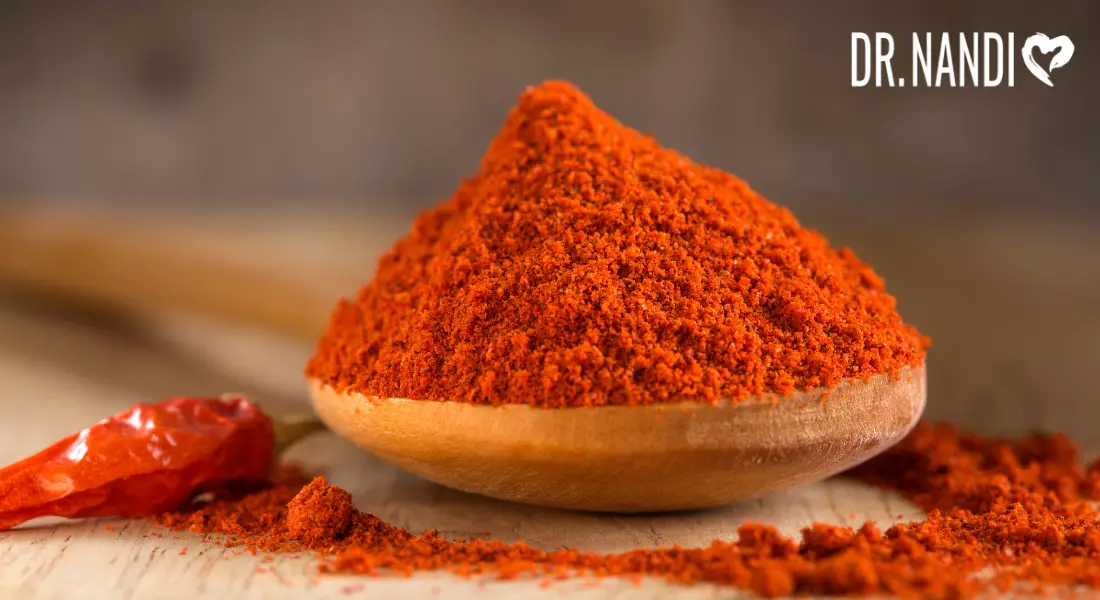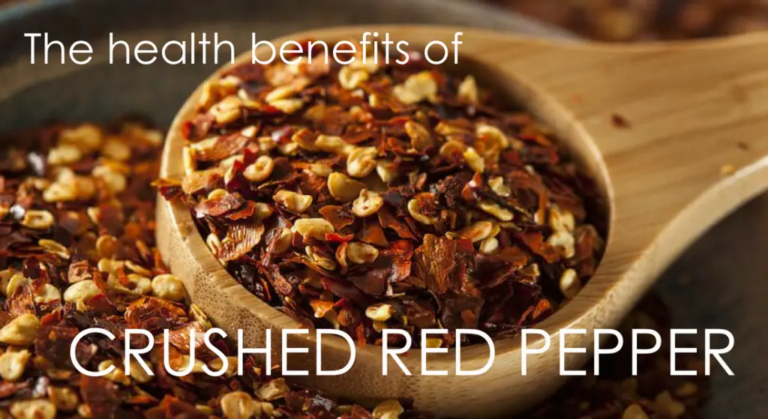Paprika is the fourth most popular spice in the world. It is made from ground and dried peppers from the Capsicum annuum species. First cultivated in Brazil and Bolivia, it was brought to Spain. Soon after arriving in Spain, it was grown in monasteries around the country. By the 16th century, paprika had become a common ingredient in Spanish cuisine.
Paprika is a versatile spice that can be used in many different dishes. It can be added to stews, soups, and sauces, or used as a rub for meats. Paprika can also be used to make a powder that can be used as a seasoning on food.
Moreover, paprika is an excellent source of many essential vitamins and minerals. It also contains carotenoids, which are compounds that give peppers their red color. These compounds have been shown to have health benefits, including reducing inflammation and protecting against certain types of cancer.
Here are nutrition facts and health benefits of paprika:
Paprika Nutrition Facts
Paprika powder is low in calories and fat and is a good source of fiber. It is also a good source of vitamins A, C, and E. A tablespoon of paprika powder contains the following nutrition:
- 19 calories
- 2.4 grams of fiber
- 1 gram of protein
- 3.7 grams of carbohydrates
- 16 milligrams of calcium
- 155 milligrams of potassium
- 12.10 milligrams of magnesium
Additionally, paprika contains carotenoids, flavonoids, and other antioxidants.
Paprika Health Benefits
Paprika is An Excellent Source of Vitamin A
Vitamin A has always been known as an essential vision-protecting nutrient. Still, it is much needed for strong immunity, healthy skin, and to keep your thyroid functioning properly. A teaspoon of paprika has nearly half the daily vitamin A requirement for women and one-third the need for men. Plus, vitamin A is essential for pregnant women to help with proper organ development in utero.
Paprika is Filled With Iron
A tablespoon of paprika provides 8 and 18 percent of the daily recommended intakes of iron needed for women and men, respectively. The iron in your food helps your cells use energy. It allows your cells to carry out a series of chemical reactions called the electron transport chain, which results in energy production. Iron also supports the function of hemoglobin and myoglobin, which are two proteins needed to transport and store oxygen required by your tissues to function properly.
Paprika is a Good Source of Vitamin E
If you need more vitamin E, consuming paprika is a great source. Vitamin E is known to help with blood clot formation and help to promote healthy blood vessel function. Vitamin E works as an antioxidant by preventing cellular lipids from being destroyed. A tablespoon of paprika supplies nearly 15 percent of the recommended daily intake needed for your body.
Paprika Helps You Sleep
Paprika is known to help promote deeper sleep due to vitamin B6. Vitamin B6 is known to have a powerful psychological and neurological effect on the body.
This vitamin contributes to melatonin production, the “sleep hormone,” helping with the normal sleep cycle. Adding paprika to your diet will also help boost the body’s levels of serotonin and norepinephrine, which are stress-reducing hormones.
Paprika Has Strong Antibacterial Properties
A protein found in paprika is known to slow the growth of certain bacteria, including E. coli and Salmonella. Researchers have found that adding paprika to your diet can slow their growth if you ingest the bacteria. Plus, paprika has been found to help with bacterial acne when consumed.
Paprika Promotes Healthy Vision
Paprika contains several antioxidants and other compounds that may benefit eye health, including vitamin E, beta carotene, lutein, and zeaxanthin. In fact, some of these nutrients have been linked to a decreased risk of age-related macular degeneration (AMD) and cataracts in studies.
Lutein and zeaxanthin, which function as antioxidants, may help to prevent eye damage. Women in the study with the greatest consumption of lutein and zeaxanthin had a 32% decreased risk of developing cataracts than those with the lowest intakes.
In a separate 4,519-person study, higher lutein and zeaxanthin intakes were linked to a decreased risk of AMD.
Paprika May Reduce Inflammation
The chemical capsaicin is found in varying amounts in different types of paprika, particularly hot ones. It’s been suggested that capsaicin binds to pain receptors on nerve cells, decreasing inflammation and pain.
Because of this, it has been shown to protect against a wide range of inflammatory and autoimmune diseases, including arthritis, nerve damage, and digestive disorders. Topical capsaicin treatments have been shown in several studies to help relieve discomfort caused by arthritis and nerve damage. However, there isn’t much research on capsaicin tablets.
Nonetheless, more study on paprika is needed.
Paprika May Improve Your Cholesterol Levels
Paprika, in particular capsanthin, a carotenoid found in this spice, may help to improve your cholesterol levels. HDL (good) cholesterol, which is linked with a decreased risk of heart disease, might be increased by capsanthin, a carotenoid present in this popular flavoring.
Rats fed diets with paprika and capsanthin showed substantial increases in HDL levels, according to a two-week trial. Carotenoids in paprika may also help reduce blood cholesterol levels, including total and LDL (bad) cholesterol, which are linked to an increased risk of heart disease.
However, further study is required.
Paprika May Have Anti-Cancer Effects
Paprika contains a variety of compounds that may help prevent cancer. Several paprika carotenoids, including beta carotene, lutein, and zeaxanthin, have been found to combat oxidative stress, which has been linked to an increased risk of several cancers.
Capsaicin in paprika has also been shown to alter the expression of numerous genes, which may lead to inhibition of cancer cell growth and survival. However, further study is required on this spice’s anti-cancer potential.
Paprika Promotes Healthy Blood Sugar Levels
Capsaicin in paprika might assist with diabetes. This is because capsaicin can modulate genes involved in blood sugar management and reduce enzymes that break down sugar in the body. It may also help people with insulin sensitivity.
Despite these findings, further study is still needed.
Paprika Is Loaded With Betacarotene
Beta carotene is transformed into Vitamin A. Vitamin A is crucial for human beings and is required for the maintenance of our skin’s health. It aids in the prevention of wrinkles. In addition to giving your skin a boost, beta carotene has been shown to benefit your brain by slowing down cognitive deterioration, which occurs with dementia and Alzheimer’s.
According to a study published in the November Archives of Internal Medicine, men who have been taking beta-carotene supplements for 15 years or more were less likely to experience cognitive deterioration.
Paprika is Good for Bone Health Maintainance for Women
The carotenoids in paprika may also aid in the maintenance of bone health in postmenopausal women. When compared to a placebo, a paprika carotenoid extract improved bone turnover in postmenopausal women, according to a study published.
The research was conducted to evaluate the effects of a daily 20mg paprika carotenoid extract (equivalent to 1.4 mg of carotenoids) or a placebo for 24 weeks on 100 healthy, postmenopausal women. The extract group had significantly lower rates of bone resorption (bone tissue breakdown) than the placebo group, suggesting that it may aid in the maintenance of bone quality in postmenopausal women.
Paprika Can Be Added to Diet Easily
Paprika is a versatile spice that may be used in many different dishes. It’s made up of three distinct types that differ in flavor and hue depending on the pepper’s growing and processing. Sweet paprika has a hint of smokiness to it, along with a touch of sweetness. Meat dishes, potato salads, and eggs are just a few of the foods that can be enhanced with a sprinkle of sweet paprika.
Hot paprika, on the other hand, has a hotter flavor and is frequently used in soups and stews like Hungarian goulash. Finally, rice, lentil, and bean dishes benefit from the sweet smoky taste of smoked paprika. You may also use paprika in a variety of dishes. Sprinkle a little on hard-boiled eggs, chopped vegetables, dips, cooked rice, roasted potatoes, and salads to add color and flavor.
While paprika supplements are also accessible, there’s just a little bit of research on their safety and effectiveness.
Frequently Asked Questions
How long does paprika last?
If properly stored in containers with tight-fitting lids, paprika can keep for roughly 3 to 4 years.
What is the difference between sweet, hot, and smoked paprika?
The sweeter or more delicately flavored paprikas are usually mainly for coloring, with a hint of flavor, while the heat of the spicy paprika is for the cook who likes a more dominant taste. The same is true with smoked paprika.
Discover different ways how you can include paprika in your daily diet. Get a FREE copy of my Superfood Cookbook.
References:
- Spices, paprika nutrition facts and analysis. (nutritionvalue.org)
- Effects of paprika carotenoid supplementation on bone turnover in postmenopausal women: a randomized, double-blind, placebocontrolled, parallel-group comparison study | Food & Nutrition Research (foodandnutritionresearch.net)
- A Randomized Trial of Vitamin E Supplementation and Cognitive Function in Women | Dementia and Cognitive Impairment | JAMA Internal Medicine | JAMA Network
- Nutrients for the aging eye – PMC (nih.gov)
- The relationship of dietary carotenoid and vitamin A, E, and C intake with age-related macular degeneration in a case-control study: AREDS Report No. 22 – PubMed (nih.gov)
- Associations between age-related nuclear cataract and lutein and zeaxanthin in the diet and serum in the Carotenoids in the Age-Related Eye Disease Study, an Ancillary Study of the Women’s Health Initiative – PubMed (nih.gov)
- Dietary sources of lutein and zeaxanthin carotenoids and their role in eye health – PubMed (nih.gov)
- Associations between age-related nuclear cataract and lutein and zeaxanthin in the diet and serum in the Carotenoids in the Age-Related Eye Disease Study, an Ancillary Study of the Women’s Health Initiative – PubMed (nih.gov)
- The relationship of dietary carotenoid and vitamin A, E, and C intake with age-related macular degeneration in a case-control study: AREDS Report No. 22 – PubMed (nih.gov)
- Harnessing the Therapeutic Potential of Capsaicin and Its Analogues in Pain and Other Diseases – PMC (nih.gov)
- Some like it hot: The emerging role of spicy food (capsaicin) in autoimmune diseases – PubMed (nih.gov)
- Influence of different drying methods on carotenoids and capsaicinoids of paprika (Cv., Jalapeno) – PubMed (nih.gov)
- Capsaicin: A review of its pharmacology and clinical applications – ScienceDirect
- Unravelling the Mystery of Capsaicin: A Tool to Understand and Treat Pain – PMC (nih.gov)
- Spices, paprika nutrition facts and analysis. (nutritionvalue.org)




















